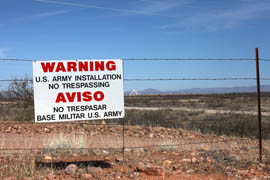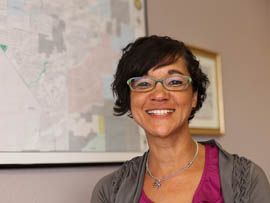Cronkite News has moved to a new home at cronkitenews.azpbs.org. Use this site to search archives from 2011 to May 2015. You can search the new site for current stories.
Lawmaker: Allow land exchanges that preserve military bases
Editor’s Note: A previous version of this story erroneously reported that the San Pedro River runs through Fort Huachuca. The river is near the base.
SIERRA VISTA – Ringed by mountain ranges and largely undeveloped, the San Pedro Valley offers Fort Huachuca 2,500 square miles ideal for testing sensitive military electronics.
Business leaders like Dan Abrams in Sierra Vista, where thousands of jobs depend on the Army base, want to keep it that way.
“We’re here because the military decided to make this their home many years ago, and without them, this town wouldn’t even exist today,” said Abrams, a small business owner and Sierra Vista Economic Development Foundation board member.
Fort Huachuca’s Buffalo Soldier Electronic Testing Range includes more than 500,000 acres of state trust land, which the Arizona Constitution mandates be leased or auctioned to benefit public education.
Supporters of Fort Huachuca and other Arizona bases want the federal government to be able to trade land elsewhere for state trust land that could be developed in ways that interfere with military operations. But voters in 2010 narrowly rejected designed to provide that option.
Now a state lawmaker wants to give voters a second chance to approve such swaps. And Gov. Jan Brewer on Tuesday signed one of two pieces of legislation needed to make that happen.
Sen. John Nelson, R-Litchfield Park, said Fort Huachuca needs protection because of its economic importance to southeastern Arizona as well as its rural setting.
“They have a very sensitive and pristine area that they need to protect,” Nelson said. “And part of it is to try to provide a mechanism where they can do that and keep that base in Arizona rather than have it go somewhere else.”
Nelson authored SB 1001, signed Tuesday, which would allow state trust land be swapped with federal land for the purpose of protecting a military base. The swap would have to be approved by the State Land Department, which administers trust land, and would be subject to independent appraisals, public hearings and approval by state voters.
But the measure wouldn’t take effect unless voters approve a change to the state Constitution proposed in SCR 1001, authored by Nelson. The resolution has passed the Senate and was awaiting action by the full House.
A broad coalition that included conservation groups, military leaders and ranchers supported the proposition that failed in 2010 by less than 10,000 votes out of 1.6 million cast.
Nelson amended this year’s legislation to require that any federal land proposed for exchange be in the same county as the state trust land in question.
Maria Baier, the Arizona state land commissioner, said certain land uses are incompatible with military bases. For example, she said, bright lights from commercial development near Marine Corps Air Station Yuma could disrupt night training while residential encroachment could curtail operations at Luke Air Force Base.
Eight-five percent of state trust land is leased for grazing, a use that is compatible with operations at Fort Huachuca, Baier said.
“It’s not the kind of mission that you can just pick up and move to anywhere else because that large of an area without the kind of interference that they’re concerned about is really difficult to find in the United States,” she said.
Sandy Bahr, director of the Sierra Club’s Grand Canyon Chapter, said the proposal ensures that land swaps are subject to public review.
“It doesn’t give open-ended authority to the State Land Department or to the Legislature,” she said. “It makes it clear that these must go to the voters, so there’s a high level of transparency and accountability.”
Bahr said the land could protect the environment as well. Preserving state trust land near Fort Huachuca would also safeguard the San Pedro River, she said.
“Trying to limit development around that upper San Pedro River is critical to its long-term survival,” she said.
Meanwhile, Fort Huachuca is critical to Sierra Vista’s survival, said Mignonne Hollis, executive director of the Sierra Vista Economic Development Foundation.
“They’re the economic driver of the community,” she said.
Paychecks from Fort Huachuca employees and service members’ trickle down to support local businesses, and the base has a contract with the city to provide its health care, Hollis said.
But for her, preserving the vast, open spaces help area residents in other ways. A horseback rider, Hollis has a pass that allows her to ride on the state trust land.
“It butts up against Fort Huachuca, and actually, it’s quite nice,” she said.









